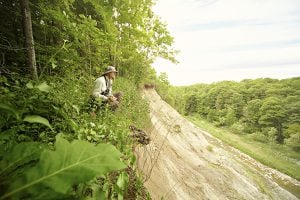Picnic at the beach
There are several picnic and beach areas, complete with pavilions, picnic tables and charcoal barbeques to set up camp for lunch or even for the day. The sandy beaches are generally well maintained and swimming is possible at some of the locations (but never swim out at the tip of the point where currents are too dangerous!).
We loaded a few coolers with snacks, sandwiches and drinks and spent a few hours at the water’s edge enjoying the sunshine. It was a great spot for the few members of our party who didn’t want to hike to the actual tip of the point, too! Most picnic and beach areas have restrooms nearby.
Walk to the tip
During COVID-19, the shuttle that normally drives visitors the 1.5 kilometres to the point isn’t operating, so die-hards have to make the round-trip walk instead. With the road closed to traffic, it’s easy walking under a canopy of trees. Some of our group stayed at the beach, but those of us determined to see the new observation tower spent about 90 minutes roundtrip.
After the 1.5 kilometres of road walking, you hit mulched and sandy paths that take you all the way out to the tip of the point. Way back in 1749, a French explorer named Gaspard-Joseph Chaussegros de Léry recorded this stretch of peninsula at 4.5 kilometres long. It’s now closer to 800 metres, sometimes as short as about 400 metres depending on the tides and water levels.
The observation tower, which opened in August 2020, is the 24-metre result of about $3 million invested into Point Pelee and offers a 360 degree view of the beginning of mainland Canada. Worth a trek up the 144 stairs if you can make it!








